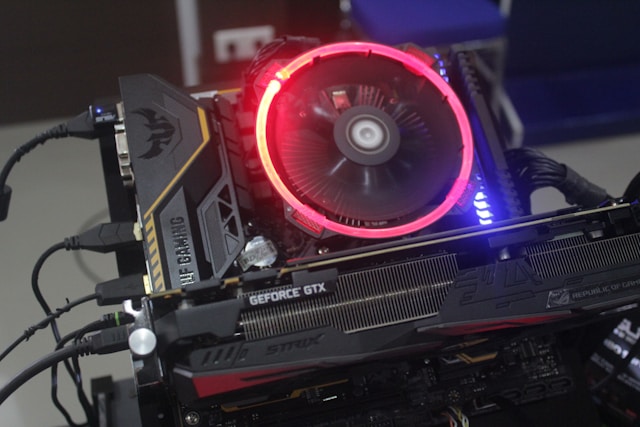The relationship between the CPU (Central Processing Unit) and GPU (Graphics Processing Unit) is crucial in determining your computer’s overall performance. Whether you’re a gamer, video editor, or 3D modeler, balancing these two components is essential for achieving optimal performance. A CPU-GPU bottleneck occurs when one component is significantly underperforming in comparison to the other, creating a system imbalance that limits overall efficiency. A bottleneck calculator is a vital tool that helps identify and quantify this performance discrepancy, enabling you to make informed decisions on hardware upgrades.
In this article, we will dive deep into how a CPU-GPU bottleneck calculator works, why it’s important, and how it can guide you toward optimizing your system for peak performance.
What is a CPU-GPU Bottleneck?
A CPU-GPU bottleneck happens when one of these components is significantly more powerful than the other, causing an imbalance in performance. If your CPU cannot process the data fast enough for the GPU to render frames, this creates a CPU bottleneck. On the other hand, if your GPU is less powerful than your CPU, you’ll experience a GPU bottleneck, where the CPU outpaces the GPU’s ability to render graphics.
For example, pairing a high-end GPU such as an NVIDIA RTX 4090 with a mid-range CPU like an Intel Core i5 could lead to a CPU bottleneck. In this scenario, the GPU has the potential to generate far more frames per second (FPS) than the CPU can process, effectively leaving performance on the table. This is where a CPU GPU bottleneck calculator becomes invaluable in identifying and avoiding such mismatches.
How Does a CPU-GPU Bottleneck Calculator Work?
A CPU-GPU bottleneck calculator analyzes the specifications of your CPU, GPU, and other system components to determine whether any component is underperforming in relation to the others. By inputting your processor model, graphics card, RAM, and system settings such as resolution and refresh rate, the calculator estimates the percentage of bottleneck between your CPU and GPU.
The output typically shows the extent of the bottleneck in percentage form. A high bottleneck percentage indicates a severe performance mismatch between the CPU and GPU. This tool helps users identify which component is causing performance issues, allowing them to make targeted upgrades rather than blindly upgrading hardware.
Why Use a CPU-GPU Bottleneck Calculator?
1. Avoiding Performance Bottlenecks in Gaming
For gamers, achieving high FPS and smooth gameplay is a top priority. If your system has a CPU-GPU bottleneck, even the most powerful GPU might not deliver the expected performance. A CPU bottleneck will cause stuttering, lag, and underutilization of the GPU, especially in CPU-intensive games like Assassin’s Creed Valhalla or Cyberpunk 2077.
A bottleneck calculator can identify whether your CPU can keep up with your GPU in the games you want to play. This helps you avoid investing in hardware that won’t deliver the desired gaming experience. For example, if you are running a 4K gaming setup, the calculator can confirm whether your GPU can handle high resolutions without being bottlenecked by your CPU.
2. Maximizing Investment in Hardware Upgrades
Upgrading a single component in your system can lead to an imbalance if you don’t consider the performance of other parts. Without proper knowledge, you might upgrade your GPU to a more powerful one, only to find out that your CPU is unable to handle the new load, thus leading to a CPU bottleneck. This situation not only wastes money but also leaves performance gains unrealized.
A CPU-GPU bottleneck calculator provides insights into which components need an upgrade, allowing you to spend wisely. By avoiding unnecessary upgrades and focusing on the weakest link in your system, you ensure that every dollar spent translates into real-world performance gains.
3. Optimizing for Specific Tasks
Different applications and tasks stress different components in your system. A bottleneck calculator helps you tailor your system configuration to your specific needs, whether it’s gaming, video rendering, 3D modeling, or even machine learning.
For instance, gaming is typically more dependent on the GPU, while tasks like video editing and 3D rendering tend to be CPU-intensive. By using a bottleneck calculator, you can optimize your system to meet the demands of the applications you use most, ensuring that neither the CPU nor GPU is underperforming in relation to the other.
4. Future-Proofing Your System
When upgrading your system, you want to ensure that your components remain relevant for several years. A bottleneck calculator helps users plan for future upgrades by assessing how well current components will work together with potential upgrades. This ensures that your system remains balanced, even as new hardware is released.
For example, if you’re planning to upgrade your GPU in the next year or two, the calculator can help you determine whether your current CPU will still be sufficient to handle the added power. This helps you avoid bottlenecks as new hardware is integrated into your system.
How to Use a CPU-GPU Bottleneck Calculator Effectively
Step 1: Input Your Hardware Specifications
The first step in using a CPU-GPU bottleneck calculator is inputting your system’s specifications. These include the CPU model, GPU model, the amount of RAM, and the settings for resolution and refresh rate. The more accurate your data, the more precise the bottleneck estimation will be.
Step 2: Analyze the Bottleneck Percentage
Once you’ve input the necessary data, the calculator will generate a bottleneck percentage. A percentage below 10% is generally considered acceptable, meaning that your system is balanced, and no significant bottlenecks are present. However, if the percentage is 15% or higher, you may need to upgrade a component to resolve the bottleneck.
Step 3: Make Informed Hardware Decisions
Use the bottleneck percentage to guide your upgrade decisions. If the bottleneck is in the CPU, upgrading to a more powerful processor will yield the best performance gains. Conversely, if the GPU is bottlenecking your system, investing in a better graphics card will help you achieve higher frame rates and smoother gameplay.
Step 4: Adjust for Future Upgrades
If you’re planning to upgrade your system in stages, the bottleneck calculator can also help predict whether future components will introduce new bottlenecks. This ensures that your system remains balanced and capable of handling new hardware for years to come.
Common Scenarios of CPU-GPU Bottlenecking
1. CPU-Intensive Games
In CPU-intensive games like Grand Theft Auto V or Microsoft Flight Simulator, the CPU does most of the work in processing the game world, AI, and physics. In these scenarios, even with a powerful GPU, a mid-range or low-end CPU can severely limit performance, creating a CPU bottleneck. Upgrading the CPU is essential to eliminate this bottleneck.
2. High-Resolution Gaming
For gamers playing at 1440p or 4K resolutions, the GPU handles most of the workload. In this case, if your GPU is not powerful enough to render frames quickly, you’ll experience a GPU bottleneck. Upgrading to a high-end GPU is necessary to achieve smooth performance in graphically demanding games at high resolutions.
3. Professional Applications
In tasks such as 3D rendering, video editing, and data processing, the CPU plays a much larger role in performance. If you’re working with professional applications, having a high-performance CPU will ensure that the system runs smoothly. A bottleneck calculator helps determine whether your current setup is sufficient for these demanding tasks or if a CPU upgrade is needed.
Conclusion
A CPU-GPU bottleneck calculator is an essential tool for anyone looking to optimize their PC’s performance. By identifying the weakest link in your system, you can make smart upgrade decisions, avoid mismatched hardware configurations, and ensure that you’re getting the most out of your investment. Whether you’re building a new PC or upgrading an existing one, using a bottleneck calculator can save you time, money, and frustration.





